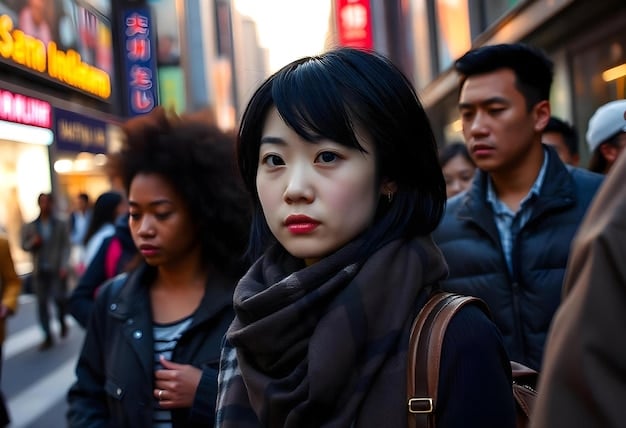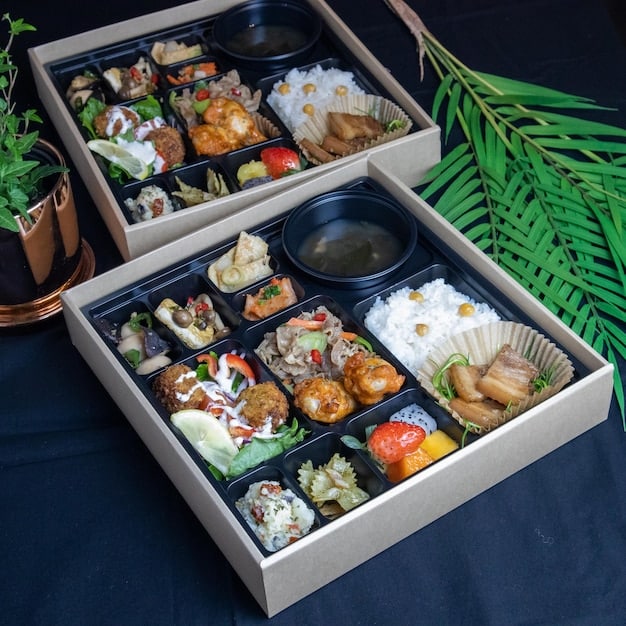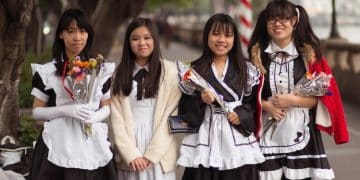Decoding J-Drama Tropes: 2025 Guide to Plot Twists and Arcs

This guide explores the identifiable patterns and narrative conventions present in Japanese dramas that, by 2025, allow discerning viewers to anticipate plot developments and character trajectories with remarkable accuracy, enhancing appreciation for storytelling nuances.
Japanese dramas, or J-dramas, have cemented their place in global entertainment, captivating audiences with their distinctive storytelling and cultural nuances. For seasoned viewers, a growing familiarity with common narrative devices and character archetypes has emerged. This guide delves into Decoding J-Drama Tropes: A 2025 Guide to Predicting Plot Twists and Character Arcs, offering an insightful look into the recurring elements that shape these beloved series. Understanding these tropes not only deepens appreciation for the genre but also provides a unique lens through which to anticipate upcoming developments, enriching the viewing experience considerably.
The Enduring Appeal of J-Drama Storytelling
J-dramas captivate millions worldwide, transcending cultural barriers through universal themes of love, friendship, struggle, and triumph. Their unique narrative rhythm, often characterized by a blend of realism and idealism, offers a refreshing alternative to Western dramas. This distinct flavor is largely shaped by a set of recurring narrative devices and character traits – often termed “tropes” – that have become hallmarks of the genre.
From high school romances featuring awkward but determined protagonists to gripping psychological thrillers with intricate plot lines, J-dramas consistently deliver engaging stories. These stories frequently draw upon established cultural values and societal norms, which in turn inform the development of specific tropes. Recognizing these patterns allows viewers to connect more deeply with the narrative, understanding the underlying messages and cultural context.
The Cultural Tapestry Behind J-Drama Narratives
Japanese society, with its emphasis on harmony, duty, and community, profoundly influences the types of stories told and how they unfold. Tropes such as the importance of “ganbaru” (perseverance) or the concept of “wa” (group harmony) are not just plot devices but reflections of deeply ingrained cultural values. Understanding this cultural backdrop is essential for truly appreciating the nuances of J-drama storytelling.
- Ganbaru (Perseverance): Characters often face immense challenges but are expected to endure and overcome through sheer effort.
- Wa (Harmony): Conflicts are frequently resolved through compromise and understanding, rather than overt confrontation.
- Senpai-Kōhai Relationship: Hierarchical mentorships are a common theme, influencing character interactions and growth.
Evolution of Tropes in a Globalized Era
While rooted in tradition, J-drama tropes are not static. As Japanese culture interacts more with global trends, these narrative conventions evolve. Modern J-dramas often experiment with traditional tropes, subverting expectations or applying them in contemporary settings. This dynamic interplay between tradition and innovation keeps the genre fresh and engaging for a global audience.
The rise of streaming platforms has also played a significant role, exposing J-dramas to a wider audience and, in turn, subtly influencing their production. Creators are increasingly aware of international tastes, leading to a broader range of stories and characterizations, though core Japanese storytelling principles remain.
Character Archetypes: The Players in the J-Drama Arena
A cornerstone of anticipating J-drama plots lies in recognizing its extensive cast of character archetypes. These recurring personalities often dictate their roles in the narrative, their relationships, and ultimately, their arcs. By 2025, these archetypes have become highly refined, almost like a secret language for devoted fans.
From the fiercely independent female lead to the stoic male protagonist with a hidden heart of gold, these character types provide a familiar framework. They allow writers to quickly establish character motivations and potential conflicts, contributing to the genre’s efficient storytelling. Understanding these roles helps viewers predict who will fall in love, who will face a moral dilemma, and who might betray whom.
The Tsundere and Dandere: Understanding Love Languages
Romance is a dominant genre in J-dramas, and character archetypes are pivotal in shaping its trajectory. The tsundere, a character initially cold or hostile but eventually revealing a warm, affectionate side, is a classic. Their inevitable softening often signals a blossoming romance. Conversely, the dandere, quiet and shy around love interests, slowly opens up, their reserved nature adding a layer of delicate charm to their romantic journey.
- Tsundere Trait: Begins with harsh words and actions, gradually softens as feelings develop.
- Dandere Trait: Extremely quiet and withdrawn, but shows kindness and warmth to those they trust.
- Predictive Power: Recognizing these types allows viewers to anticipate romantic pairings and development of their relationships.
The Mentor Figure and the Quirky Sidekick
Beyond romance, support characters also adhere to common archetypes. The wise, often eccentric mentor figure provides guidance and sometimes comic relief, pushing the protagonist towards their goal. The quirky sidekick, loyal and often socially awkward, serves as a sounding board and source of unwavering support, often providing unexpected insights or comedic timing.
These supporting roles are crucial in J-dramas, not just for advancing the plot but for enriching the protagonist’s journey. Their predictable behaviors and functions within the story allow viewers to anticipate moments of crisis, breakthrough, or lighthearted relief, knowing these characters will play their designated parts.

Plot Devices and Narrative Structures: The Blueprint of J-Drama
J-dramas often follow discernible patterns in their plot construction and narrative structure. While each series offers unique twists, a familiarity with these blueprints allows for an educated guess about upcoming events and the overall direction of the story. By 2025, these structural elements are almost instinctively understood by dedicated fans.
From the classic “underdog triumphs” narrative to the “misunderstanding leads to growth” arc, many J-dramas build upon established blueprints. This predictability isn’t a flaw; rather, it provides a comforting familiarity that allows viewers to focus on the subtleties of character development and the emotional core of the story, rather than constantly second-guessing the plot.
The “Slice-of-Life” Trope: Everyday Dramas, Profound Lessons
Many J-dramas embrace the “slice-of-life” approach, focusing on the ordinary experiences of characters rather than grand, sweeping narratives. This trope excels at portraying realistic human emotions and relationships, finding profound meaning in the mundane. While seemingly simple, these dramas often build to significant character transformations and heartfelt conclusions.
- Focus on Daily Life: Emphasizes routines, small interactions, and gradual personal growth.
- Subtle Conflict: Emotional or interpersonal conflicts are often internal or resolved through quiet reflection.
- Relatability: Audiences connect with the realistic portrayals of struggles and joys.
The “Unlikely Pairing” and Its Predictable Outcomes
In romantic or buddy-cop J-dramas, the “unlikely pairing” is a beloved trope. Two characters who initially seem incompatible—perhaps from different social classes, with opposing personalities, or even sworn rivals—are forced to collaborate or live together. The predictable outcome is often mutual understanding, respect, and eventually, deep affection. This trope relies on the journey of overcoming initial friction to forge a strong bond.
This narrative device thrives on the contrast between its protagonists, creating opportunities for comedic misunderstandings, heartfelt confessions, and significant personal growth for both individuals. Viewers can almost always anticipate the shift from animosity or indifference to a foundational relationship.
The Art of the Reveal: Predicting Plot Twists
While J-dramas are celebrated for their emotional depth and character development, they are also adept at crafting compelling plot twists. However, for the observant viewer in 2025, even these twists often follow specific patterns or are foreshadowed in subtle ways. Identifying these narrative cues is key to predicting the unexpected.
Plot twists can range from the sudden revelation of a character’s true identity to unforeseen reversals of fortune. The skill lies in integrating these twists organically into the storyline, making them feel both surprising and inevitable. Experienced viewers learn to look for incongruities, unusual character behaviors, or repeated motifs as potential indicators.
The “Secret Identity or Hidden Past” Trope
A classic J-drama twist involves a character harboring a secret identity or a hidden, often traumatic, past. This information is usually revealed at a critical juncture, altering perceptions of the character and often propelling the plot in a new direction. Foreshadowing for this often comes in vague remarks, avoidance of certain topics, or mysterious encounters.
- Subtle Hints: Characters might react unusually to specific words or people.
- Flashbacks: Brief, fragmented flashbacks offer glimpses without revealing the full truth.
- Behavioral Changes: A character’s actions might seem inconsistent with their established persona until the reveal.
The Betrayal and Redemption Arc
Another common twist involves a seemingly loyal character betraying the protagonist, only to later seek redemption. This trope allows for exploration of complex moral dilemmas and the power of forgiveness. The betrayal itself often serves as a significant turning point, forcing the protagonist to confront harsh realities and grow stronger as a result. The ‘betrayer’ often has their own complex motivations, revealed piecemeal.
Predicting this twist often involves paying attention to characters who exhibit conflicted loyalties or who have something significant to gain from the protagonist’s downfall. Their eventual redemption arc, while challenging, usually reinforces themes of forgiveness and the possibility of change.
Genre-Specific Tropes: Nuances in Different J-Drama Categories
Just as in other forms of media, J-dramas have specific tropes that are more prevalent within certain genres. A romantic comedy will lean heavily on misunderstandings and meet-cute scenarios, while a mystery might feature the brilliant, socially awkward detective. By 2025, understanding these genre-specific patterns further refines prediction skills.
These genre-specific tropes act as unspoken rules within their respective categories, providing a familiar framework for both creators and audiences. They contribute to the distinct flavor of each genre, allowing viewers to quickly understand the narrative conventions they can expect, from the pacing to typical character interactions.
High School Dramas: First Loves and Academic Pressure
In high school J-dramas, common tropes revolve around puppy love, intense friendships, and the pressure of academic success (often tied to university entrance exams). The transfer student trope, the school festival arc, and the love triangle are almost guaranteed elements. These stories often explore themes of self-discovery, social awkwardness, and the intensity of adolescent emotions.
- Transfer Student: Often catalyzes new friendships or rivalries.
- School Festival: A traditional backdrop for romantic confessions or dramatic turning points.
- Love Triangle: A classic conflict where the protagonist must choose between two suitors.
Medical Dramas: The “Miracle Cure” and Dedicated Doctors
Japanese medical dramas frequently feature highly skilled, dedicated doctors who perform seemingly impossible surgeries or discover “miracle cures.” The trope of the maverick doctor who bends rules for the sake of patients, often clashing with hospital bureaucracy, is prevalent. These dramas emphasize the human element of medicine, the dedication required, and the emotional toll on practitioners.
Viewers can often anticipate a scenario where a patient’s life hangs in the balance, and only the protagonist’s unconventional genius or tireless effort can save them. The ultimate triumph over impossible odds usually reinforces themes of hope and perseverance in the face of death.

Modern J-Drama Tropes and Their Evolving Meanings
As storytelling evolves, so do the tropes. While many classic J-drama tropes remain, new ones emerge, and existing ones are reinterpreted for a contemporary audience. The year 2025 sees a blend of tradition and innovation, where understanding how these tropes adapt is crucial for accurate predictions.
Modern J-dramas are increasingly incorporating global issues and diverse perspectives, leading to more complex characters and nuanced interpretations of established tropes. This evolution means that while the core blueprint might be familiar, the execution can be strikingly fresh and unexpected.
The “Work-Life Balance” Struggle
In the highly competitive Japanese society, the “work-life balance” struggle has become a significant modern trope. Characters, often young professionals, grapple with demanding careers and personal aspirations. This trope explores themes of burnout, societal expectations, and the search for personal fulfillment outside of work. Predictably, protagonists often find a way to reconcile these pressures, sometimes by challenging corporate norms.
This trope resonates deeply with contemporary audiences, reflecting real-world anxieties. The narrative typically follows the protagonist’s journey from overwhelm to finding a healthier equilibrium, often with the support of friends or a significant other, leading to a satisfying resolution where personal happiness is prioritized.
The “Found Family” Dynamic
The concept of “found family” where unrelated individuals form strong, familial bonds, has gained prominence. This trope challenges traditional notions of family, emphasizing chosen relationships and mutual support. Whether it’s a group of colleagues, housemates, or even disparate individuals brought together by circumstance, their journey to forming an unbreakable bond is a predictable and heartwarming arc.
- Shared Adversity: Characters bond through overcoming common challenges or living together.
- Emotional Support: Provides a sense of belonging and unconditional acceptance.
- Challenging Norms: Often highlights the warmth and strength found outside traditional family structures.
Embracing the Predictive Viewing Experience
Decoding J-Drama Tropes: A 2025 Guide to Predicting Plot Twists and Character Arcs isn’t about spoiling the fun; it’s about enriching it. By recognizing recurring patterns, viewers can engage more deeply with the narrative, appreciating the clever ways writers adapt and subvert expectations. It transforms passive viewing into an active, analytical, and ultimately, more satisfying experience.
Understanding these tropes allows for a more sophisticated appreciation of J-drama as an art form. It’s about seeing the artistry in how familiar elements are reconfigured to create fresh stories, how character archetypes are given new depth, and how plot twists, even when anticipated, still deliver emotional impact. The journey of prediction becomes part of the journey of enjoyment.
The Joy of Anticipation and Subversion
The beauty of tropelicious viewing lies not just in predicting accurately but also in appreciating when a drama elegantly subverts expectations. A well-executed subversion of a known trope can be even more satisfying than a straight adherence, as it demonstrates creative ingenuity. Knowing the rules allows viewers to truly appreciate when they are broken in a clever way.
This active engagement with the material fosters a greater connection to the characters and their stories. When a drama masterfully plays with audience expectations, it builds a stronger, more lasting impression, solidifying its place in the viewer’s memory as a particularly well-crafted piece of entertainment.
| Key Aspect | Brief Description |
|---|---|
| 🎭 Character Archetypes | Recognizable personalities (e.g., Tsundere, Dandere) predict romantic and narrative roles. |
| 📖 Plot Structures | Common narrative blueprints (e.g., underdog triumphs, slice-of-life) guide story progression. |
| 🔄 Predictable Twists | Foreshadowed elements like hidden pasts or betrayals add satisfying resolutions. |
| 🌐 Evolving Tropes | Modern J-dramas adapt themes like work-life balance and “found family” for contemporary appeal. |
Frequently Asked Questions About J-Drama Tropes
A J-drama trope refers to a recurring theme, narrative device, character archetype, or plot element found across many Japanese dramas. These patterns are often culturally influenced and provide a familiar framework that helps audiences understand and connect with the stories, sometimes even allowing prediction of future events.
J-drama tropes are common because they are rooted in Japanese cultural values, storytelling traditions, and audience expectations. They provide a shorthand for creators to convey complex ideas and contribute to the genre’s distinct identity. Their familiarity offers comfort and a sense of shared understanding among viewers.
No, knowing tropes generally enhances the viewing experience. Instead of spoiling, it allows viewers to appreciate the nuances, clever adaptations, and subversions of familiar patterns. It transforms passive watching into an active engagement, where anticipation and recognition become part of the enjoyment and learning process.
By 2025, J-drama tropes have evolved to include more contemporary themes like work-life balance, found family dynamics, and broader takes on diversity. While traditional elements remain, they are often reinterpreted or combined in innovative ways to reflect changing societal values and appeal to a global audience, maintaining freshness.
While predicting every detail of a complex plot twist is challenging, understanding common tropes can significantly increase your ability to anticipate general directions or impending revelations. Look for setups like hidden pasts, seemingly insignificant details, or conflicted loyalties as strong indicators for future major plot developments.
Conclusion
The journey through Decoding J-Drama Tropes: A 2025 Guide to Predicting Plot Twists and Character Arcs reveals that these recurring elements are far from mundane. They are the intricate threads that weave the rich tapestry of J-drama storytelling, offering both comfort in familiarity and delight in clever adaptation. For the attuned viewer, understanding these tropes transforms the act of watching into an engaging intellectual exercise, allowing for a deeper appreciation of the genre’s artistry and its profound cultural insights. By 2025, the ability to anticipate and recognize these patterns becomes a badge of honor for the dedicated J-drama enthusiast, enhancing every moment spent immersed in these compelling narratives.





